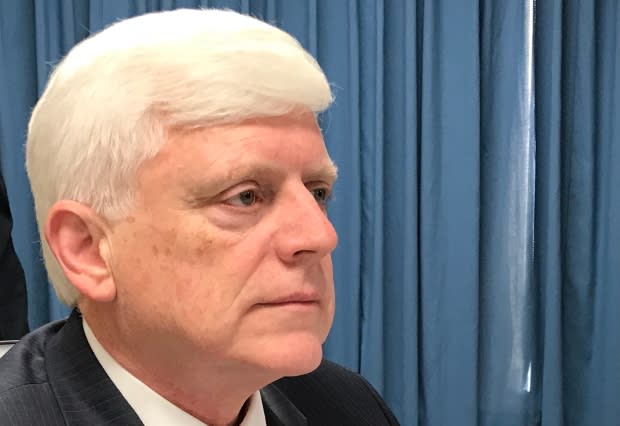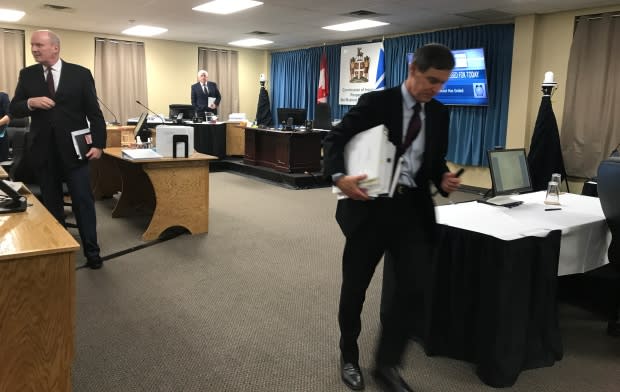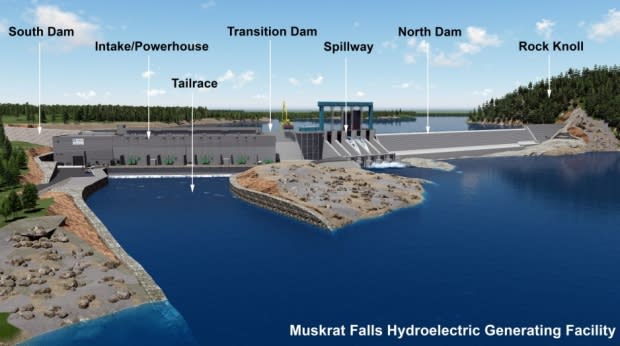Ed Martin tells reporters 'I'll go all day' in defense of Muskrat Falls
Ed Martin left the Muskrat Falls inquiry Thursday just as he arrived: full of confidence and bravado and a strong belief the hydroelectric project he stewarded for years is still the best option.
"Why am I talking now? They pulled me back in. I didn't ask for this. I'll go all day long. No problem. This is the right project," Martin boasted while talking with reporters outside the hearing room Thursday evening.
The former Nalcor CEO endured many hours of questions and even a jaw-dropping verbal undressing during one especially heated moment at the inquiry this week.
'It's right then, it's right now, and it's sure going to be right in the future.' - Ed Martin
But his support for the project, and his defence of his role in its planning and delivery, is as unwavering as ever.
And after four full days of testimony, he made his way to the media room to declare it once again.
"It's right then, it's right now, and it's sure going to be right in the future," he declared.
No other option can beat it, says Martin
In short, despite billions in cost overruns, a first-power delay of at least two years, and evidence that he adopted a very aggressive and risky approach to setting cost and schedule estimates, Martin believes a future with Muskrat Falls is still better than any other alternative.

"The overall benefits of this project, when you add them up and put dollars against it, against the alternatives, there is a massive amount of margin favouring Muskrat Falls. And that margin is large enough that I cannot mathematically see any other option beating it."
He's been the subject of intense criticism for his influential role in Muskrat Falls, and has come under fire at the inquiry this week for his appetite for risk on a publicly-funded megaproject, for his apparent disregard of anyone recommending a more cautious approach, and for the way he communicated the risks to his government masters.
But Martin repeatedly stood his ground against an onslaught of questions from inquiry co-counsel Kate O'Brien and under cross-examination from other lawyers, including Geoff Budden of the Muskrat Falls Concerned Citizens Coalition, and from counsel representing Labrador Indigenous groups.

At one point on Wednesday, Martin was reprimanded by inquiry Commissioner Richard LeBlanc for his "rude" attitude and for "trying to run the show."
Martin's tone was more agreeable on Thursday, but his position was unchanged, and he refused to acknowledge any shortcomings in the planning for Muskrat while on the witness stand, sticking by his belief that billions in dividends from ratepayers and cash from the export of power can be used to offset skyrocketing energy bills.
His optimism is in stark contrast to the dire predictions of Muskrat critics who say the project has threatened the very viability of the province's financial solvency.
"We are well positioned for the first time in my estimation in history for the future," Martin, who left Nalcor under a cloud of controversy in 2016, told the commission at one point.
Martin admits to incorrect assumptions
But when pressed by reporters about the $6.2 billion capital cost estimate that was sold to the public at sanctioning in 2012, Martin acknowledged there were some incorrect assumptions.
Construction costs have since soared to at least $10.1 billion, although the all-in cost with financing is closer to $13 billion.
Martin blamed contractor Asaldi and its slow start on the project for a "significant impact" on costs, and said the decision not to do more geotechnical work in Labrador for the transmission line to Newfoundland was a mistake that drove up costs because the anchors required to secure the steel towers needed to be more robust.
'The fact that some pieces of it could have been underestimated? Well I think that's an obvious thing.' - Ed Martin
But Martin said he was confident in the estimate at the time of sanctioning.
"The fact that some pieces of it could have been underestimated? Well I think that's an obvious thing. But pieces of it, other things happened. And on these types of projects, things happen outside of what you can know, or know what's coming."
Least-cost option
Muskrat was selected as the least-cost option for Newfoundland's future electricity needs following a comparative analysis with the isolated island power grid.
The analysis by Nalcor reviewed the 50-year costs for each option, and found that the present value, or cumulative present worth, for Muskrat over that period was preferred by $2.4 billion over the isolated option, though this scenario can now be disregarded because of cost overruns, and government has said power rates could double within a few years unless mitigation measures are taken.
Martin said the scenario under which Muskrat was created provides the answer for rate mitigation.
"There's value built into the economics to deal with that," Martin said, referring again to the sale of excess power on the export market, using the Maritime Link to Nova Scotia, and what he says will be billions from ratepayers in Newfoundland and Labrador.
Meanwhile, under questioning Thursday from John Hogan, lawyer for the province's consumer advocate, Martin was asked why he was so supportive of a project that far exceeded the province's energy needs?

Hogan highlighted the Electrical Power Control Act, which requires electricity be delivered to consumers "at the lowest possible cost, consistent with reliable service."
The island market will require roughly 40 per cent of the 824-megawatt generating capacity at Muskrat, but the financing arrangement for the project was approved based on a requirement that Newfoundland ratepayers foot the entire bill.
"Why wasn't it built to meet demand at the time to ensure that ratepayers are only going to pay for what they use?" Hogan asked.
By opting for Muskrat, Hogan said the province removed any flexibility it had with the isolated option, whereby generating capacity could be enhanced as the demand required.
Martin agreed with that point, but repeated his belief that maintaining the isolated option would be costlier, riskier and less reliable than the so-called interconnected option, which includes two separates links to the North American power grid.
"When we were analyzing this it was cheaper in the short, medium and long term to build Muskrat and spill all that water until we needed it. That was cheaper than the isolated," Martin said, referring to the excess energy at Muskrat Falls.
Hogan retorted: "We've lost all that flexibility as opposed to building as we need, or as we may not need."
We've lost all that flexibility as opposed to building as we need, or as we may not need. - Lawyer John Hogan
The project includes a generating station on the Lower Churchill River in Labrador, a transmission line to Newfoundland's Avalon Peninsula that includes a subsea cable beneath the Strait of Belle Isle, and a new line connecting Muskrat Falls with the much larger and iconic Upper Churchill generating station.

The project also includes the Maritime Link, which includes a subsea cable beneath the Cabot Strait that will bring Muskrat power to Nova Scotia as part of 35-year deal with Emera Inc.
Martin is the 55th witness to appear at the inquiry since public hearings began in September, and is arguably the most important, since he's widely regarded as the architect of a project that Premier Dwight Ball described this year as the biggest financial mistake in the history of Newfoundland and Labrador.

